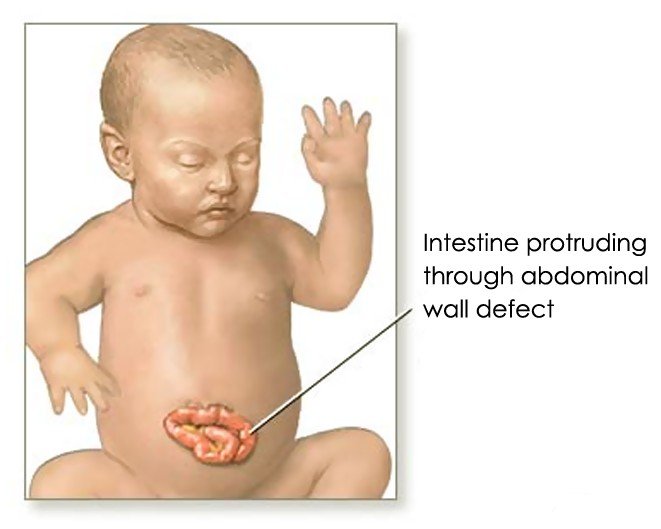Gastroschisis
What is Gastroschisis?
This is a congenital birth defect. When a baby has this birth defect their viscera, which are the internal organs in their abdominal cavity, protrude from their abdomen wall. The particular organ that is involved in this case is a protruding loop of small intestine on one side of their umbilical cord. It can also involve other organs like your liver. There are three other names that this medical condition is called which are:
- Laparoschisis
- Abdomionschisis
- Paraomphalocele
The size of the defect is usually less than four centimeters. With the advances in surgical techniques today and better intensive care management the survival rate for infants born with gastroschisis is ninety percent. This birth defect is more frequent in males than females and most babies born with this defect have a low birth rate. Each year in the United States there is approximately one thousand nine hundred births with this congenital birth defect.
Gastroschisis Symptoms
There are only two symptoms associated with this birth defect, which are:
- Having a lump in their abdomen.
- Having the intestines sticking through the abdominal wall near their umbilical cord.
Causes of Gastroschisis
Gastroschisis is considered a type of hernia, which means rupture, This medical condition looks similar to having an omphalocele, which is when the baby’s intestines or other abdominal organs stick out of their belly button and is covered with a membrane, and not from around the umbilical cord. Gastroschisis is also not covered with a membrane. Gastroschisis is caused by incomplete fetal development. There also appears to be an inherited component but there other cases in which it just develops spontaneously without any reason.
The biggest risk factor that can cause gastroschisis is the age of the mother. It seems that it is seen in more mothers of a younger age. There is also evidence that suggest if the mother uses certain medications in the early stages of their pregnancy can have this happen to their baby. Other causes can include:
- High risk pregnancies like those that are complicated by infection.
- Smoking
- Drug abuse
- Anything that can contribute to low birth weight.
Clinical studies have also linked women taking aspirin during their pregnancy as to having a high risk of having a baby born with gastroschisis.
Diagnosis
Many times your obstetrician can diagnosis this birth defect when the blood work you had done shows abnormalities. It is more common for gastroschisis to be found when it shows up on the ultrasound. Once this birth defect is diagnosed you will most likely be referred to an obstetrician who treats high risk pregnancies. This is because both the mother and baby will need special care.
Treatment for Gastroschisis
When your obstetrician tells you that you are having or have had a baby with gastroschisis it can sound pretty frightening but in reality it is very treatable. If the pregnancy, delivering, and corrective surgery are handled right the prognosis can be excellent. In some pregnancies where this has been diagnosed the mother will undergo a caesarian section in order to reduce any complications that could happen during a vaginal deliver. If the parents know that their baby is going to be born with gastroschisis they should talk to a neonatal surgeon to make sure that their baby will get the right surgery and treatment after they are born.
If this birth defect is found before the baby is born, the mother will need to have special monitoring to ensure that her unborn baby stays healthy. At this time they will make plans for a careful delivery, most likely a caesarian section, and how they are going to handle the problem after the baby is born. No matter when gastroschisis is diagnosed, it is still considered a surgical emergency. Most babies will have to have more than one surgery. Of all the cases of gastroschisis only approximately ten percent could have it done on e with one surgery.
Once the baby is born the neonatal surgeon will tuck the intestine back on their body and close the incision. They will also use a pressure bandage to help promote healing. If the intestine is swollen because of an infection the neonatal surgeon will need to keep some of the small intestine outside their body in a sac that is called a silo. A silo is a mesh sack that stitched around the borders of the defect. Once they have it stitched they will pull the edges of the defect up. If the neonatal surgeon has to go this route he will gradually push the intestine back into their body over time. They may also have to wait if the abdominal cavity is too small to push all the intestines back in at the same time.
If the baby has difficulty breathing because of the abdominal pressure after surgery they will probably be put on a ventilator during the early stages of healing so they are able to breathe easier. Once the baby has healed they will usually experience no long term problems. Once the baby has had surgery they will need other treatments such as:
- Being given nutrients intravenously.
- Monitoring their temperature because if the intestine could not all be placed back into the proper place because with exposed intestine there can be a lot of body heat that escapes.
Gastroschisis Pictures
Pictures of Gastroschisis…

